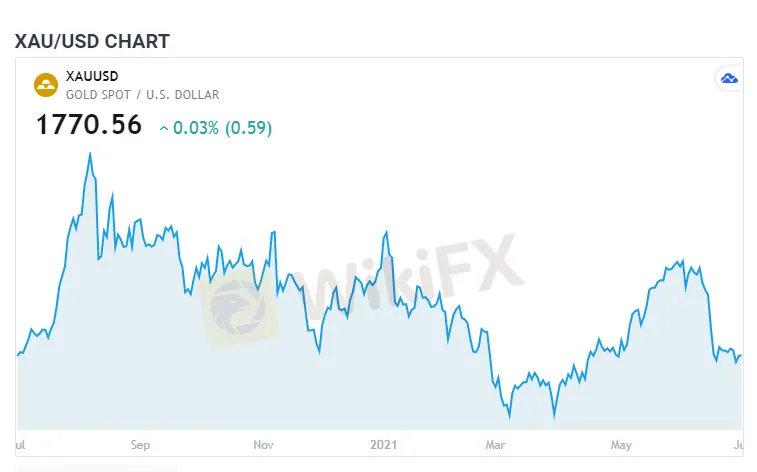简体中文
繁體中文
English
Pусский
日本語
ภาษาไทย
Tiếng Việt
Bahasa Indonesia
Español
हिन्दी
Filippiiniläinen
Français
Deutsch
Português
Türkçe
한국어
العربية
Gold Price Forecast
Abstract:XAU/USD drops back below $1,770 on firmer USD.
Gold (XAU/USD) edges higher around $1,770, after snapping a two-day downtrend, during the initial Asian session on Thursday. The quarter-end positioning and downbeat Treasury yields seem to have contributed to gold‘s bounce off a 2.5-month low the previous day. However, hawkish Fedspeak, fears of the coronavirus (COVID-19) and firmer US dollar keep a tab on the commodity’s upside momentum.

US Equities closed mixed and the 10-year Treasury yields dropped 1.2 basis points (bps) to 1.47% but S&P 500 Futures begin July with no major moves after its Wall Street benchmark refreshed record top. As the risk barometers flash mixed signals, coupled with the ongoing contrasting play between the covid headlines, signals of tapering and upbeat US data, gold traders seek fresh cues to justify the latest recovery moves. This highlights the Asian session data, namely Japan‘s Tankan Manufacturing gauge for Q2 and China Caixin Manufacturing PMI for immediate direction. Even so, risk catalysts stay in the driver’s seat.
After falling to its lowest level since mid-April at $1,750 on Tuesday, gold managed to stage a decisive recovery on Wednesday and was last seen gaining 0.65% on a daily basis at $1,772.
Despite the broad-based USD strength, the XAU/USD pair didn't have a difficult time pushing higher during the American trading hours with the sharp decline witnessed in the US Treasury bond yields helping gold attract investors. Currently, the benchmark 10-year US T-bond yield is losing nearly 2% on the day at 1.446%.

Additionally, quarter-end flows and rebalancing of large positions may have triggered profit-taking and helped XAU/USD retrace a portion of this week's decline.
Meanwhile, the monthly data published by the Automatic Data Processing (ADP) Research Institute showed on Wednesday that employment in the US private sector increased by 692,000 in June. This reading came in better than the market expectation of 600,000 and provided a boost to the greenback ahead of Friday's Nonfarm Payrolls report. The US Dollar Index, which tracks the USD's performance against a basket of six major currencies, was last seen trading at its highest level in more than two months at 92.41.
In a recently published analysis, Karen Jones, Team Head FICC Technical Analysis Research at Commerzbank, said gold remains offered below $1,790 and looks to retreat to the key support located at $1,735.
“While above there we will retain our longer-term upside bias,” Jones added. “Longer-term, we still target the $1959/65 November 2020 high and the 2021 high. These guard the $1989/78.6% retracement and the $2072 2020 peak.”
- Gold technical outlook
With Wednesday's rebound, the Relative Strength Index (RSI) indicator on the daily chart rose modestly to 35, suggesting that the pair corrected its oversold conditions but doesn't yet have enough bullish momentum for consistent recovery.
On the upside $1,785 (upper limit of last week's consolidation channel) aligns as an interim resistance ahead of $1,790 (100-day SMA) and $1,800 (psychological level, Fibonacci 50% retracement of April-June uptrend).
The initial support is located at $1,750 (June 29 low) ahead of $1,730 (static level).
Stay tuned on WikiFX for the latest market trend!


Disclaimer:
The views in this article only represent the author's personal views, and do not constitute investment advice on this platform. This platform does not guarantee the accuracy, completeness and timeliness of the information in the article, and will not be liable for any loss caused by the use of or reliance on the information in the article.
WikiFX Broker
Latest News
Germany's Election: Immigration, Economy & Political Tensions Take Centre Stage
WikiFX Review: Is IVY Markets Reliable?
Brazilian Man Charged in $290 Million Crypto Ponzi Scheme Affecting 126,000 Investors
ATFX Enhances Trading Platform with BlackArrow Integration
Become a Full-Time FX Trader in 6 Simple Steps
IG 2025 Most Comprehensive Review
SEC Drops Coinbase Lawsuit, Signals Crypto Policy Shift
Construction Datuk Director Loses RM26.6 Mil to UVKXE Crypto Scam
Should You Choose Rock-West or Avoid it?
Franklin Templeton Submitted S-1 Filing for Spot Solana ETF to the SEC on February 21
Currency Calculator







